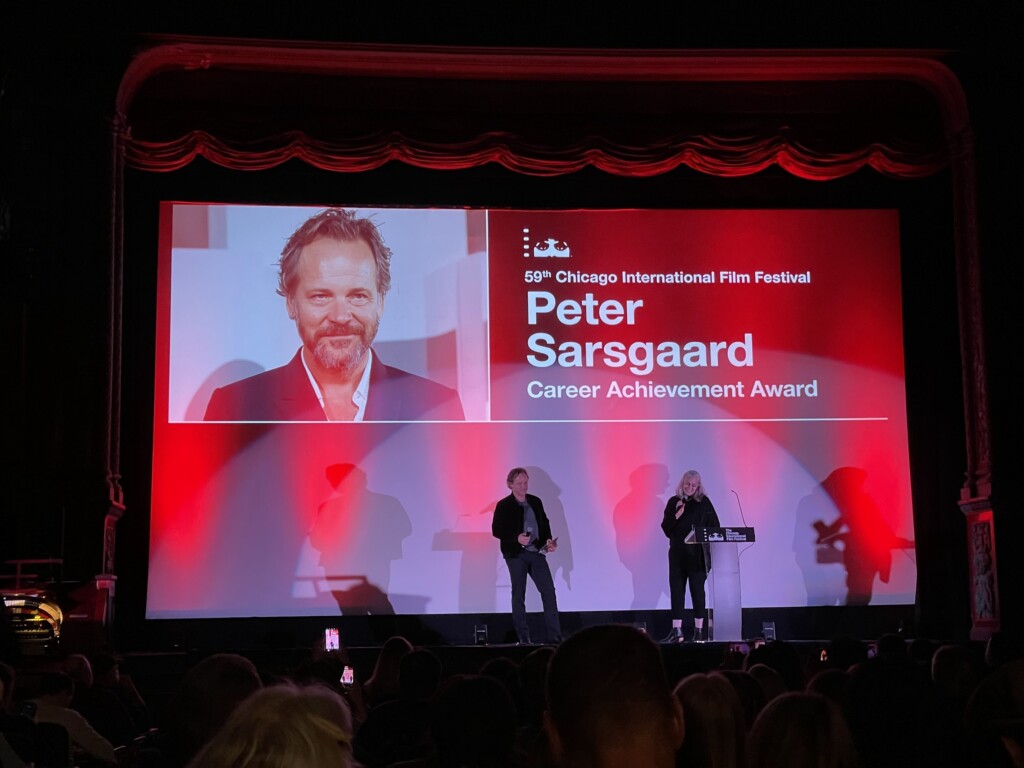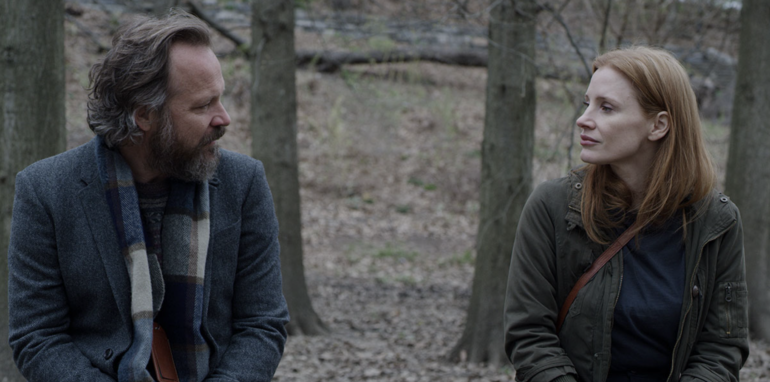“When people ask you about this movie,” said Peter Sarsgaard, “I don’t want you to say, ‘It’s about a guy with dementia.’”
Sarsgaard made this comment during an interview with Northwestern University’s Nick Davis at Music Box Theatre on Friday, October 20, immediately following the screening of Memory. This film, written and directed by Michel Franco (Chronic, Nuevo Orden), had been one of the most anticipated movies at the 59th Annual Chicago International Film Festival. At the 2012 festival, Franco’s After Lucia received the Silver Hugo Special Jury Prize. Earlier this year, Memory premiered at the Venice Film Festival, where it earned an eight-minute standing ovation, and Sarsgaard received the Volpi Cup for best actor. Sarsgaard was presented with a Career Achievement Award at the Chicago Memory screening.
When talking with others about the movie, it’s challenging not to focus on the central character of Saul — played by Sarsgaard — who has early-onset dementia. Sarsgaard shares the lead opposite Jessica Chastain as Sylvia, who herself is recovering from alcoholism and sexual abuse.
Sarsgaard (Shattered Glass, Garden State) and Chastain (Zero Dark Thirty, Interstellar), two big names, seem almost out of place in this intimate and quiet independent film. But this is the kind of movie that performers who may typically appear in big budget movies choose to do because something in the film speaks to them. The characters in Memory will also likely speak to many of us.
Remembered, Half-Remembered, Mis-Remembered
It’s not hard to understand why Sarsgaard wanted people to avoid focusing on Saul’s dementia. There’s a lot going on in this story beyond Saul’s deteriorating memory and confusion. At the highest level, the movie is about the recollections that shape us — recollections sometimes remembered, half-remembered or mis-remembered. This is a movie with many long pauses in dialogue, as characters look to one another, trying to figure out other people, situations and themselves.
As the audience, we’re not always sure what to think about the characters. Saul has lost large chunks of his memory, so when Sylvia accuses him of a misdeed he may have committed years ago, he says he has no memory of it. We can’t be certain if he’s suppressing a memory, has no actual memory of the incident, is a liar or is, perhaps, innocent. In this way, the experience of the film reflects uncertainties about the characters, and we don’t know — at least initially — if they’re good people or not, sympathetic or not. We just can’t be certain exactly what we’re supposed to think of them. And neither can they.
After encountering each other at a high school reunion, a series of events lead to Sylvia becoming, somewhat reluctantly, Saul’s caregiver. Both Saul and Sylvia have been broken by memory — or the lack thereof. Saul’s memory — both short- and long-term — is clearly full of gaps; Sylvia is living with memories that are painful but not always clearly recalled.
Memory is a movie of considerable subtlety, with acting that engages a multitude of micro-expressions and restrained communications that convey difficult memories, sometimes bottled-up, barely beneath the surface, sometimes largely or even completely forgotten but still hovering in the background, like ghosts. There’s a grayness and murkiness to the movie; several key scenes take place at night, and the days are cloudy, grim, sometimes rainy. The low light and darkness of Memory contrasts with other films by Franco, including the brilliantly sunlit Los Angeles of Chronic or sunny Mexico City in the chilling Nuevo Orden (New Order). In both Memory and Chronic, the locked-down camera slows down the pace, makes us really look at the scenes, and think about what’s happening before our eyes. This pacing requires some patience on the part of the viewer, but the static and sometimes silent scenes have a way of pulling us into the movie in a way that more dynamic and noisy films may not.
Making Connections
During the interview at the Music Box, Sarsgaard explained that when he first received the script, “I thought, I’m not going to do this. And then something changed as I started to read it. I had a personal connection to one of the conditions of the character. My uncle, who was a very dear man to me, had early-onset dementia from playing football and boxing. I had that connection. Then I went on this long walk with Michel, where I kind of introduced him to New York City. We walked for hours together, and to me, the thing that always makes me want to do anything is the connection. And this is why I’m here tonight, having a connection with you guys. This is exactly what I want to be doing. We’ve all become so inured to what real behavior is; and I’m dying to play characters with someone like Michel who gives you the time to show an experience that could never be replicated by AI.”
Artificial intelligence is in air, and it’s one of the main concerns of those who are right at this moment on strike in Hollywood. Legal issues surrounding the strike have limited what actors can say about, for instance, movies they’ve appeared in, and other topics related to the business of their craft. Because of those concerns, there were no red-carpet interviews at the screening of Memory. Chastain, however, had earlier commented to Variety magazine that “we need protections from AI implementation, and there needs to be a streaming revenue share. I think everyone’s really afraid to be the one to say anything — especially if you’re a successful actor. We’ve been trained from the moment we got our first job to be quiet because we don’t know when our next job is coming. It takes a lot of support from each other to link arms and do this,” adding that she hopes Memory will “create a renaissance … of independent cinema.”

Don’t Expect a Neat Conclusion
One is accustomed to a certain glossy perfection with Hollywood movies — every move is calculated, every hair is in place — but Memory seems to allow a lot of random, almost uncontrollable elements to come on to the screen; there’s a grittiness to the look of this movie. It feels real.
Sarsgaard explained during his interview at the Music Box that a brownstone location in the movie was somebody’s house that had not been “dressed” by a set designer. “So, this brownstone,” Sarsgaard said, “had all the stuff in it from the guy who owned the house, including a photo album that had the picture of his wife, a red head who had passed away. And that photograph is actually in the movie,” and it works perfectly because as Saul’s deceased wife had red hair, one wonders if that’s why he was initially drawn to Sylvia: something about her triggered a memory, a trace of the past that Saul himself probably did not realize.
“There are microscopic clues and details in this movie,” Sarsgaard went on. “I think that might have been why I wore a scarf or a sport coat that was too small for me,” because in a sense, the old clothes that no longer fit reflected a barely remembered time before the onset of his memory loss.
Although there is a hint of resolution, there is no neat conclusion, which seems appropriate for a movie about two people, broken and yet mending, one tormented by memories and the other tormented by an inability to remember.
Cinema/Chicago, the presenting organization of the Chicago International Film Festival, is dedicated to “fostering better communication between people of diverse cultures through the art of film and the moving image.” Memory loss is a cross-cultural phenomenon, and with many of us living longer, we’re all facing the prospect of living with slowly deteriorating recollections. My mother and father both lived into their nineties and faced some of the issues raised in Memory. Watching the film, I remembered how they, like Saul, sometimes just had to laugh at the gaps in memory, the bewilderment at every day events, the bizarreness and messy confusion of the human comedy.
How to Help:
The Chicago International Film Festival and various programs flourish under the auspices of Cinema/Chicago — a non-profit cultural and educational organization dedicated to bridging the gap between people of diverse cultures and access to the art of film. Your donation helps support this mission.

More From Better:
- 31 of the Best Things To Do in Chicago and the Suburbs in October 2023
- Twist Out Cancer Expands Programming Accessibility to Reach More Individuals Touched By Cancer
- The Top Chicago-Area Private Schools and Tutoring Companies for 2023 – Guide Highlights

David Hammond is Dining and Drinking Editor at Newcity and contributes to the Chicago Tribune and other publications. In 2004, he co-founded LTHForum.com, the 15,000 member food chat site; for several years he wrote weekly “Food Detective” columns in the Chicago Sun-Times; he writes weekly food columns for Wednesday Journal. He has written extensively about the culinary traditions of Mexico and Southeast Asia and contributed several chapters to “Street Food Around the World.”
David is a supporter of S.A.C.R.E.D., Saving Agave for Culture, Recreation, Education and Development, an organization founded by Chicagoan Lou Bank and dedicated to increasing awareness of agave distillates and ensuring that the benefits of that awareness flow to the villages of Oaxaca, Mexico. Currently, S.A.C.R.E.D is funding the development of agave farms, a library and water preservation systems for the community of Santa Catarina Minas, Oaxaca.

